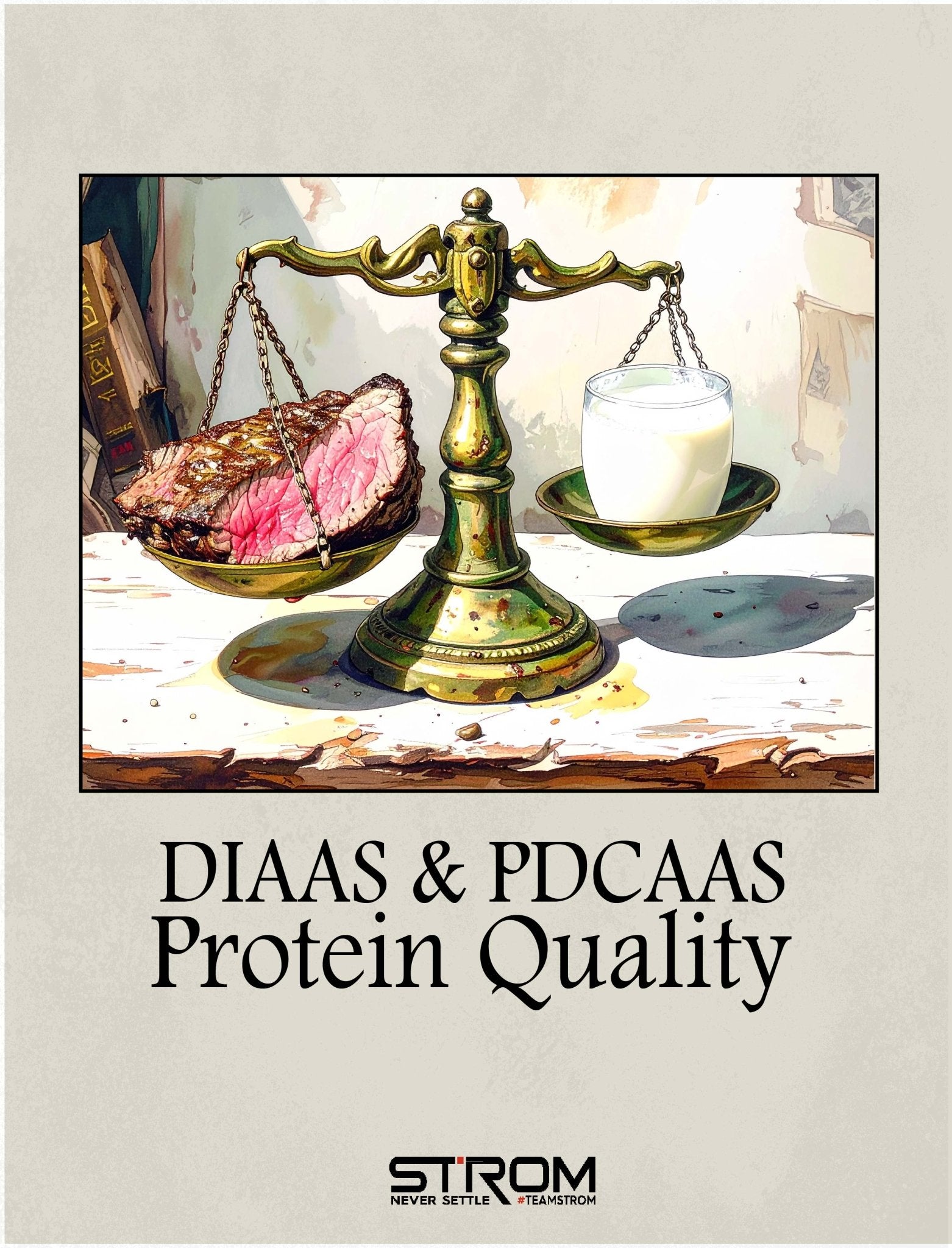Why This Matters
When you look at protein powders or food labels, you might see confusing scores like "PDCAAS 1.0" or "DIAAS 120." These numbers are supposed to tell you how good a protein is for your body. But what do they actually mean? And more importantly, which one should you trust when choosing protein for your health goals?
Understanding protein quality matters because not all proteins are created equal. Your body needs specific building blocks called amino acids to build muscle, repair tissues, and stay healthy. Some proteins give you all the amino acids you need, while others fall short. The scoring systems help you figure out which is which.
This article will break down the two main protein scoring systems, explain why the newer DIAAS system is better than the old PDCAAS, and help you make smarter protein choices for your health.
Not all proteins are created equal — PDCAAS and DIAAS scores reveal which ones truly fuel muscle, repair, and health.

Quick Facts
-
Main benefit: DIAAS provides a more accurate assessment of protein quality than the older PDCAAS system
-
Research backing: Based on ileal digestibility studies and updated amino acid requirement analysis
-
Best for: Anyone choosing protein supplements, planning meals, or optimizing nutrition
-
Key difference: DIAAS measures absorption in the small intestine, while PDCAAS relies on less accurate fecal measurements
The Science: How Protein Quality Scoring Works
Your body needs nine indispensable (essential) amino acids (IAAs or EAAs) — protein building blocks that your body cannot produce on its own. Think of them as key ingredients in a recipe: miss one, and the recipe fails.
The essential amino acids are: histidine, isoleucine, leucine, valine, lysine, threonine, phenylalanine, methionine (plus cysteine), and tryptophan. When you eat protein, your digestive system breaks it down into these amino acids, which are absorbed in the small intestine and then transported through the bloodstream to build muscle, repair tissues, and support health.
PDCAAS (Protein Digestibility Corrected Amino Acid Score)
-
The older scoring system
-
Identifies the most limiting amino acid in a protein source
-
Corrects for digestibility based on fecal samples
-
A score of 1.0 means the protein theoretically provides all essential amino acids when consumed in adequate amounts
DIAAS (Digestible Indispensable Amino Acid Score)
-
The newer, more accurate method
-
Measures amino acid absorption directly in the small intestine (where absorption occurs)
-
Avoids inaccuracies caused by bacterial metabolism in the colon
-
Provides a clearer picture of how much of a protein your body can actually use

Indispensable Amino Acids (IAAs)
These nine amino acids drive protein quality scoring:
-
Leucine: Triggers muscle protein synthesis
-
Lysine: Key for tissue repair, often limiting in plant proteins
-
Methionine + Cysteine: Antioxidant production and tissue maintenance
-
Threonine: Immune and gut health support
-
Valine + Isoleucine: Energy during exercise and recovery
-
Phenylalanine: Needed for neurotransmitters and brain function
-
Tryptophan: Converts to serotonin, impacts mood and sleep
-
Histidine: Supports tissue growth and immunity
Dispensable Amino Acids (DAAs)
Also called “non-essential” — your body can make them, but consuming them improves protein utilization. Research shows IAAs plus DAAs together increase protein synthesis efficiency compared to IAAs alone.
Who Benefits Most from DIAAS?
-
Athletes & active individuals needing precise recovery and performance support
-
Older adults with reduced muscle protein synthesis efficiency
-
People with digestive issues who need highly absorbed protein sources
-
Nutrition professionals planning meal programs or recommending protein powders
DIAAS matters most when:
-
Comparing protein powders and supplements
-
Planning meals for muscle growth, recovery, or healthy aging
-
Following plant-based diets where protein combining is key
Practical Tips
-
Look for DIAAS scores on supplements:
-
≥100% = excellent quality
-
75–99% = good quality
-
-
Aim for 1–3 g protein per kg body weight daily for optimal health and performance
-
Remember: A lower DIAAS doesn’t make a protein “bad.” Quality differences only matter when total protein intake is low.
Important Considerations
-
Scoring limits: Both systems assume amino acids act independently, but interactions matter (e.g., high leucine can deplete valine and isoleucine).
-
Individual variation: Age, illness, training status, and gut health influence amino acid needs.
-
Don’t overlook DAAs: Complete proteins with IAAs and DAAs may be more effective than isolated amino acids.
FAQs
Q: Is a higher DIAAS always better?
Yes, but only when comparing similar serving sizes.
Q: Should I avoid proteins below 100% DIAAS?
No. Scores of 75–99% are still good. You can combine protein sources or eat larger portions.
Q: Do meat eaters need to worry?
Animal proteins typically score very high. Plant-based eaters need to be more strategic.
Q: How much protein do I really need?
While official requirements are ~0.66 g/kg, research suggests 1–3 g/kg daily for optimal performance and longevity.
Research References
-
FAO (2016) – Protein quality as determined by the Digestible Indispensable Amino Acid Score
-
WHO Technical Report Series 935 (2007) – Protein and amino acid requirements in human nutrition
-
FAO Expert Consultation (2013) – Dietary protein quality evaluation in human nutrition
-
Journal of Nutrition (2015) – PDCAAS vs DIAAS in protein quality
-
Journal of Sports Sciences (2011) – Dietary protein for athletes
-
Medical Journal of Australia (2012) – Protein and vegetarian diets
Conclusion
DIAAS gives a more accurate picture of how your body uses protein, especially when intake is marginal or when choosing supplements. For most people eating varied diets with enough total protein, both systems work — but DIAAS is the gold standard when quality truly matters.



Essential (Indispensable) Amino Acids: What Your Body Needs Daily
Cystatin C – The Better Kidney Test Athletes Should Be Using